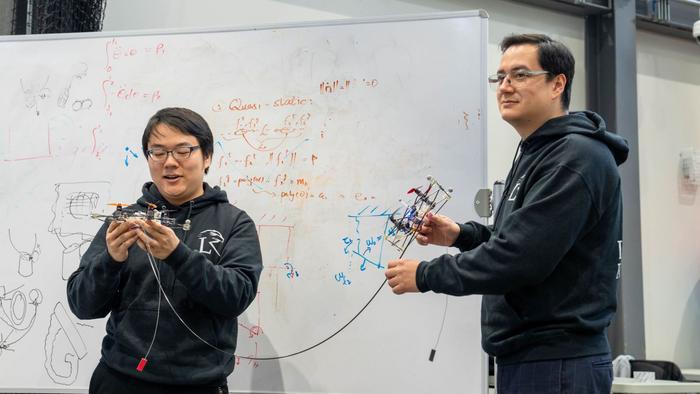When we think about drones, we tend to think about Amazon. But their potential is much greater, and arguably far more important, than dropping off a box of laundry pods by lunchtime (an idea that’s struggled to take off since Jeff Bezos floated it more than a decade ago).

Credit: Douglas Benedict/Academic Image
When we think about drones, we tend to think about Amazon. But their potential is much greater, and arguably far more important, than dropping off a box of laundry pods by lunchtime (an idea that’s struggled to take off since Jeff Bezos floated it more than a decade ago).
Aerial robots could be a huge asset, saving time, money, and workers’ well-being, in industries like construction where humans often have to heft materials up multiple floors, says David Saldaña, an assistant professor of computer science and engineering. They could also deliver lifesaving supplies in disaster areas. “The goal would be to get to a point where people don’t have to touch the robot at all,” says Saldaña. “Instead, we could just tell the robot to pick up that box of medicine and deliver it where it is needed.”
Traditional aerial systems in the literature have centered on robotic arms for autonomous grasping, which are heavy and hard to fly with as they change the drone’s center of mass. Weight-saving solutions have included using an origami-like construction and very small motors. Saldaña and his team were recently awarded a three-year, nearly $600,000 grant from the National Science Foundation for an idea that takes an entirely different approach: using cables, knots, hitches, and often multiple robots to move objects in the air.
The project involves developing algorithms that will allow drones to overcome friction and actually tie a knot in a cable without getting entangled themselves. “We can’t use the traditional reinforcement learning algorithms for this,” he says. “We have to make our own because they have to learn very fast, since robots in the air need to operate fast.”
The team will work with Subhrajit Bhattacharya, an assistant professor of mechanical engineering and mechanics, who will do the topological planning that will allow the robots to adapt to the specific requirements of securing individual items, like a chair versus a table. (Topology is the mathematical study of properties preserved through the twisting, stretching, and deformation—but not the tearing—of an object.)
The team will also be using hitches. “We have a new concept called a polygonal hitch,” says Saldaña. “Pairs of robots can make one side of the polygon, and are in charge of that side only. The polygon can be scaled up or down depending on the size of the object you’re moving.”
While the ultimate goal is to create a more efficient aerial delivery, the sheer number of problems that need to be solved first means that Saldaña will be happy to eventually perfect the transport of two items: a basketball and a solar panel. “Both will require a mesh where the cables are held together by friction, not with knots. And that means using multiple robots to interlace multiple cables, which is a very difficult task right now for robots. But this is a completely new way to look at transportation in aerial robots.”
Related Links
- NSF Award Abstract (# 2322840): AerialHitches: Forming and Controlling Hitches for Fully Autonomous Transportation Using Aerial Robots with Cables
- Rossin College Faculty Profile: David Saldaña
- Rossin College Faculty Profile: Subhrajit Bhattacharya
- Lehigh University: SwarmsLab
- Lehigh University: Autonomous and Intelligent Robotics (AIR) Lab



